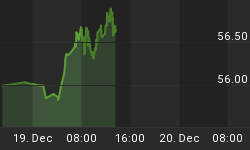1982 was not the start of the greatest bull market ever seen in human life.
In 1982 the markets just realized that a completely fiat-monetary system could survive, on a global scale for the first time, after a decade full of doubts about this surviving. So they acted consequently. They adjusted for the new monetary unit, and its corollary: a never-ending debasement!
Therefore, what you see every day looking at your charts is something virtual, a sort of plastic surgery to reshape reality. If you want to know with a fair approximation what the real story is, take a look at the first two chart below. They are the charts of Dow Jones and S&P 500 since 1959, adjusted for the increase in M2. They have been elaborated by Enrico M. Di Francia. We choosed Fed data not seasonally adjusted, because we've never paid our bills in a seasonally adjusted way.


Are you seeing the real story? Actually, Dow and S&P 500 today are worth less than in the 1959!
Let's see if these charts can tell us something more.
It looks like we stepped in another decade full of doubts about the surviving of the current monetary system or, at least, we are witnessing a general reset in the system.
Be sure! The system can still survive, because of its global nature, and because never Governments have had such a pervasive power on the choices and perceptions of the people. Even if a currency has lost 95% of its purchasing power, it can very well lose another 95% of that power in the future, and then another 95% again. The Zeno paradox here applies!
Forget any comparison with 1929! It would lack any sense! In 1929 the dollar was a certain weight of gold; today it's just a piece of colored paper with some funny writings on it.
In a fiat-money system, every economic depression will be inflationary, and every debt collapse will involve the destruction of the fiat-currency tied to that debt. There have been precise and recurring historical evidences about this!
Even if the system will survive, I'm certain it will not be anymore completely US dollar-centric. At the very least, it will have to share the privilege with another currency (euro is the only suitable from a quantitative point of view). The Chinese currency could be a viable alternative too, when Chinese will decide to get a real currency. Remember: I'm talking about fiat-currency here, not Money (i.e. Gold).
If the system survives and as far as the stock market indexes are calculated in a nominal way, those of you willing to short those markets are urged to use extreme caution, unless you can get some puts M2-adjusted. The rules of the game are set against you, as much as going long Gold and Silver at the Comex (but without the physical constraint that could destroy Comex at any moment). If the system survives, Dow at 36.000 nominal could be a conservative assumption.
The third chart below is a chart of Gold adjusted for the increase in M2.

From this chart you can draw two alternative conclusions:
- either the Powers-that-be have succeeded in eliminating the monetary component from Gold, through bad press, obscene lies and a scientific price cap.
- or they have not such a power, because every human being knows unconsciously that in 5000 years of history Gold has always been the only thing to stand when everything else was falling apart, and now it is surging like a tremendous Nemesis against the counterfeiters.
I would opt for the second conclusion. In this case, Gold at present is the second cheapest asset class available in the world (the cheapest is Silver, whose heavy industrial use and consume, however, fades somewhat its monetary component).
Let me now end up with a wish.
I hope that the last release of the US trade deficit will wipe out that idiocy stating a weak currency is the best thing for your trade balance.
I hope that two years of battered dollar and soaring trade deficit will be enough to silence all the simple minds stating such a foolishness.
As everyone can see, a falling dollar has done nothing to correct the trade deficit; it's the trade deficit crushing the dollar instead!
The trade balance is the difference between a nation's import and export. A weak currency will make you pay a lot more for the goods you import, offsetting every (supposed) increase in the goods you export. In fact, the price is not always the key selling point in a decision to buy: if you produce filthiness, I will not buy it even if it is damn cheap.
But above all, you must have something to export! You must produce goods if you want to export them. It's quite difficult to export a haircut or other fashionable services.
And as US manifacturing is facing extinction, USA produces very little suitable for export!
That's because the real and only culprit of the US trade deficit is the indecently high consumption/GDP ratio. It's a vicious circle!
US producers, either quantitatively and competitively, can't satisfy this abnormal consumer demand, which of course then shifts towards foreign products. Every dollar going to a foreign producer is a dollar subtract to an American producer, who in turn will invest and produce even less, and will employ fewer US workers, and so on and on.
And it does not matter if the foreign producer is a branch of an American company. American companies operating in a foreign country enrich almost totally THAT country, and belong to that country's trade balance.
To balance the trade, US consumer should consume a lot less and save a lot more. It's the only way!
Otherwise, it's going to be the weak dollar itself to stop their orgy of consumption, in a bad way: a so worthless dollar and so few and low wages that they can't allow anything at all.















